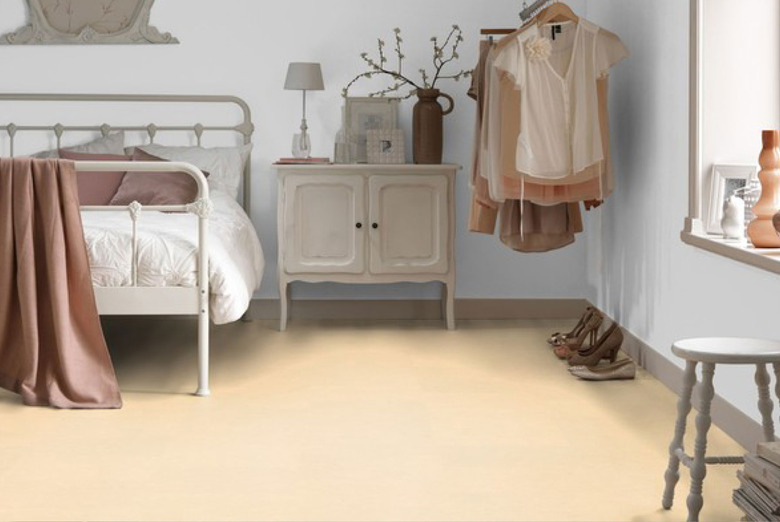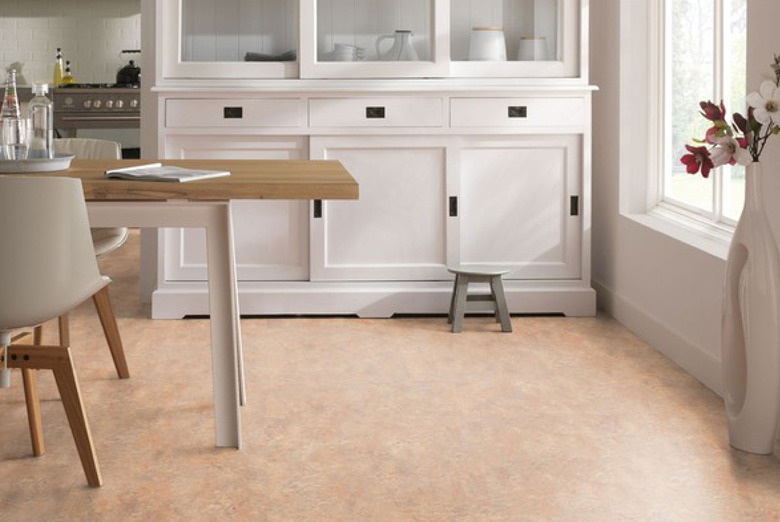Asbestos In Linoleum Floor: What Do I Do?
Asbestos is a hazardous material that is present in some older linoleum flooring materials. It can cause lung cancer, mesothelioma, cancer of the larynx and ovaries and a health condition called asbestosis caused by fibrosis of the lungs. People with asbestosis can have debilitating breathing problems and a chronic cough, according to the American Cancer Society.
The use of asbestos in building materials such as insulation, rolled roofing, siding and floor tiles was common in the first half of the 20th century, and if you have an older home, it may be lurking in your floor tiles. Before you panic, it's important to realize that the best course of action may be to simply leave the tiles alone. When encased in floor tiles that are in good condition, asbestos is not in a friable state and can't become airborne, but that isn't true if the tiles are cracked or damaged.
If your floor tiles or sheet flooring are actually linoleum, you have less to worry about than if they are another material. While asbestos is useful as a binding agent in the manufacture of vinyl and rubber floor coverings, it isn't needed to make linoleum tiles or sheet flooring. However, you're not completely in the clear because asbestos was a common ingredient in the mastic used to hold these flooring materials to the subfloor.
What Makes Asbestos Dangerous
What Makes Asbestos Dangerous
Asbestos is a class of minerals known as hydrous magnesium silicates, and it exists in more than one form. Chrysotile asbestos, the most common form, consists of spiral fibers, while amphibole asbestos fibers are long and needle-like. Asbestos fibers are fire resistant and durable, and they can be woven into fabric or incorporated with other fabrics and materials to make them stronger.
When inhaled, the extremely thin fibers can stick to the throat, windpipe and bronchi and may be cleared by coughing and eventually swallowed. Some of the fibers, however, can make it to the lungs, where they lodge in the pleura, or outer lung lining, and cause irritation that eventually leads to cancer and other illnesses.
Where You Might Find Asbestos in the Home
Where You Might Find Asbestos in the Home
The use of asbestos has been common in multiple industries throughout history and especially during the 19th and early 20th century. Besides being included in floor tiles, sheet flooring and tile adhesive, some of the purposes for which it was used included:
- Cement, plaster and drywall joint compound
- Wall, pipe and electrical insulation
- Rubber door gaskets
- Ironing board covers and pot holders
- Wall texturing
If your home was built before 1980, there's a good chance some of the materials used to build it contain asbestos. This doesn't necessarily put you at risk, however. As long as the asbestos is locked into the material and can't become airborne, it may pose little risk to your home's occupants.
Asbestos in Linoleum and Vinyl Flooring
Asbestos in Linoleum and Vinyl Flooring
Because linoleum was invented long before vinyl, people often refer to both types of flooring as linoleum, but there's a big difference. Linoleum is an all-natural floor covering composed of dried linseed oil, wood dust, cork and jute, and it doesn't contain asbestos. Vinyl is a synthetic plastic, and manufacturers often included hefty amounts of asbestos for stability and fire resistance.
One Armstrong World Industries vinyl resilient sheet flooring product thought to have been installed in 1967 was tested in a lab and found to contain 70 percent asbestos. Such products, some sold under the brand name Solarian, were installed as recently as 1980, long after governmental restrictions on asbestos were initiated.
You can tell the difference between linoleum and vinyl by looking at the pattern. A vinyl pattern is obviously embossed on the surface, whereas a linoleum pattern extends all the way through the material, giving the flooring material a translucent depth. The type of pattern is often a dead giveaway. Linoleum patterns are often floral or geometric, but they are usually more basic than vinyl patterns due to the fact that they are created by pigmentation and not by embossing.
Is Removal Necessary?
Is Removal Necessary?
Asbestos-containing materials can exist in one of two states: friable and nonfriable. Nonfriable materials are those in which the asbestos is locked and cannot become airborne. Resilient flooring is a nonfriable asbestos-containing material as long as it's in good condition, and as such, no immediate action is necessary.
The safest course of action is to leave the nonfriable flooring intact because any attempt to cut, scrape or otherwise remove it turns it into friable asbestos, a hazardous material. If possible, cover it with another layer of flooring. Laminate flooring or luxury vinyl tiles are two good options because they float on the existing floor and don't need to be glued or nailed.
Many older resilient floors have cracks, cuts and other damage. If the floor is true linoleum, damage does not present a danger of asbestos contamination unless the damage extends all the way to the subfloor and exposes the mastic, which may contain asbestos. Older vinyl or rubber floors that are damaged are a different story because the tiles can release asbestos, so they need to be removed.
Even if the flooring isn't damaged, you may want to remove it for one of a number of other reasons. You may be undertaking a major remodel, or you may need to make modifications to the subfloor. Even if the vinyl and linoleum don't present the same danger of asbestos exposure, you should treat both types of flooring as if they do when it comes to removing them.
Can You Do It Yourself?
Can You Do It Yourself?
DIY asbestos removal is not recommended and can put you and others in your family at risk of asbestos exposure. Some states allow homeowners to remove asbestos inside the home themselves but not the exterior of the home, and some states place a limit on the square footage that can be removed without a permit. In California, the limit is 100 square feet, according to A Consumer's Guide to Asbestos, published by the Contractors State License Board.
Professional asbestos abatement is expensive, but it's also guaranteed. If you do the job yourself, there's a chance that you may track asbestos dust to other parts of the house or worse. Moreover, you may run afoul of state regulations regarding abatement and disposal if you don't do thorough research before you begin the project.
Rubber Underlayment May Contain Asbestos
Rubber Underlayment May Contain Asbestos
Some very old types of flooring that you may find in buildings that date back to the early 1900s have an attached rubber underlayment, and this underlayment may contain asbestos. This type of flooring is dangerous because old underlayment tends to become flaky and crumbly, and fibers can become airborne every time you sweep or vacuum.
The flooring may be stapled to the subfloor or it may be simply placed on top like a rug, and the underlayment may be attached to the flooring or independent of it. Either way, both the flooring and the underlayment have to go for your safety and that of your family.
References
- InspectApedia: Identify Types of Resilient Flooring or Sheet Flooring That May Contain Asbestos
- Janitized: Can A HEPA Filter Remove Asbestos?
- Asbestos.com: History of Asbestos
- Contractors State License Board, California Department of Consumer Affairs: A Consumer's Guide to Asbestos
- American Cancer Society: Asbestos and Cancer Risk
- Major Safety: N95 and R95 Respirators – The Difference?

